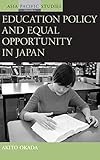Education Policy and Equal Opportunity in Japan / Akito Okada.
Material type: TextSeries: Asia-Pacific Studies: Past and Present ; 4Publisher: New York ; Oxford : Berghahn Books, [2011]Copyright date: ©2011Description: 1 online resource (218 p.)Content type:
TextSeries: Asia-Pacific Studies: Past and Present ; 4Publisher: New York ; Oxford : Berghahn Books, [2011]Copyright date: ©2011Description: 1 online resource (218 p.)Content type: - 9780857452672
- 9780857452689
- 371.2/070952 23/eng/20230216
- LA1312 .O4145 2012
- online - DeGruyter
| Item type | Current library | Call number | URL | Status | Notes | Barcode | |
|---|---|---|---|---|---|---|---|
 eBook
eBook
|
Biblioteca "Angelicum" Pont. Univ. S.Tommaso d'Aquino Nuvola online | online - DeGruyter (Browse shelf(Opens below)) | Online access | Not for loan (Accesso limitato) | Accesso per gli utenti autorizzati / Access for authorized users | (dgr)9780857452689 |
Browsing Biblioteca "Angelicum" Pont. Univ. S.Tommaso d'Aquino shelves, Shelving location: Nuvola online Close shelf browser (Hides shelf browser)

|

|

|

|

|

|

|
||
| online - DeGruyter Dynamic Belonging : Contemporary Jewish Collective Identities / | online - DeGruyter Caring for the 'Holy Land' : Filipina Domestic Workers in Israel / | online - DeGruyter Social Policy in the Smaller European Union States / | online - DeGruyter Education Policy and Equal Opportunity in Japan / | online - DeGruyter Nordic Paths to Modernity / | online - DeGruyter Gendered Money : Financial Organization in Women's Movements, 1880-1933 / | online - DeGruyter Anthropologies of Education : A Global Guide to Ethnographic Studies of Learning and Schooling / |
Frontmatter -- CONTENTS -- FIGURES AND TABLES -- ACKNOWLEDGEMENTS -- NOTES ON STYLE -- JAPANESE TERMS -- ABBREVIATIONS -- INTRODUCTION -- 1 THE INITIAL APPLICATION OF EQUAL OPPORTUNITY TO THE EDUCATION SYSTEM IN JAPAN, 1868–1944 -- 2 THE INITIAL POSITION OF THE CONCEPT OF EQUAL OPPORTUNITY IN EDUCATION, 1945–1950 -- 3 THE DEVELOPMENT OF THE NEW PERSPECTIVE ON EQUAL OPPORTUNITY IN EDUCATION, 1951–1959 -- 4 THE DEVELOPMENT OF THE CONCEPT OF EQUAL OPPORTUNITY UNDER THE HIGH ECONOMIC GROWTH PERIOD, 1960S–1970S -- 5 FROM HUMAN CAPITAL TO MARKET VALUES IN EDUCATION, 1980S–PRESENT DAY -- 6 EDUCATIONAL REFORM AND EQUALITY OF OPPORTUNITY IN CONTEMPORARY JAPAN -- CONCLUSION -- Appendix 1 THE JAPANESE SCHOOL SYSTEM IN 1937 -- Appendix 2 THE JAPANESE SCHOOL SYSTEM IN THE 1980S -- Appendix 3 THE JAPANESE SCHOOL SYSTEM IN 2008 -- BIBLIOGRAPHY -- INDEX
restricted access online access with authorization star
http://purl.org/coar/access_right/c_16ec
In many societies today, educational aims or goals are commonly characterized in terms of “equality,” “equal opportunity,” “equal access” or “equal rights,” the underlying assumption being that “equality” in some form is an intelligible and sensible educational ideal. Yet, there are different views and lively debates about what sort of equality should be pursued; in particular, the issue of equality of educational opportunity has served as justification for much of the postwar restructuring of educational systems around the world. The author explores different interpretations of the concept of equality of educational opportunity in Japan, especially as applied to post-World War II educational policies. By focusing on the positions taken by key actors such as the major political parties, central administrative bodies, teachers’ unions, and scholars, he describes how their concepts have developed over time and in what way they relate to the making of educational policy, especially in light of Japan’s falling birthrate and aging society.
Mode of access: Internet via World Wide Web.
In English.
Description based on online resource; title from PDF title page (publisher's Web site, viewed 25. Jun 2024)


